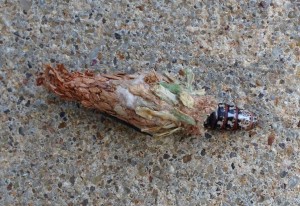Hello fellow readers, While sitting with Mom outside her nursing home in Virginia, I noticed a crust of bread being hauled off by an ant. I marvel at how much an ant can carry – ten to fifty times their body weight, they say. Mom, who inspired my gardening start, can’t talk much anymore. Still, we share the joy of observing nature.
It’s a bagworm baby.
After lunch, we revisited the spot. The Hospice nurse came to pay a visit and noticed the two-and-a-half-inch ‘crust’ was crawling within a few feet of Mom’s wheelchair. We observed the mysterious sack of brown needles from a nearby arborvitae shrub (Thuja occidentalis) being moved by the resident wormy thingy.
The entire lower section of the arborvitae appeared dead. Upon closer inspection, the evergreen shrub with its scale-like leaves had several sacks of browned needles that look like pinecone ornaments. On the ground were dropped bags of bagworms (Thyridopteryx ephemeraeformis) which are among the most damaging insects to arborvitae, juniper, pine, and spruce. They also can attack deciduous trees such as locusts and sycamore. That evening I researched the lifecycle of bagworms.
Bagworms travel with their homes.
Bagworms are dark brown caterpillars that grow an inch long while adding to the bag they live in, built from the plant material they feed on. The females live their entire life in the bag. The adult males become black moths that mate with the females, laying up to 1,000 eggs before dying.
The eggs overwinter in the bag and hatch in late spring. Then the tiny caterpillars spin a silk strand 1 to 3 feet long that catches in the wind and carries them wherever the wind blows. This resourceful mode of transportation is called “ballooning,” which they may repeat until they land on a suitable host. They then begin constructing their bags as they feed on the foliage.
A heavy infestation of bagworms can completely defoliate and kill a shrub. The easiest way to get rid of bagworms is to pick them off and drown them in a bucket of water mixed with a few tablespoons of liquid soap.
It’s curious to me why Mom’s bagworm was on the move. It turns out they take their bags with them to find fresh feeding areas. Yet there was still plenty to eat on the host arborvitae. Sometimes maybe it’s just time to move on.
Garden Dilemmas? AskMaryStone@gmail.com
Side note: For bagworms out of reach, there are biological controls safe for birds and beneficial insects, such as spraying with the bacterium Bacillus thuringiensis (Bt) after the larvae have hatched in the spring. The bagworms eat the treated foliage, sicken and die. There’s also a beneficial nematode, Steinernema carpocapsae, that feeds on bagworms that must be sprayed onto the bags before the female bagworm lays her eggs.
Column updated 4/29/22




